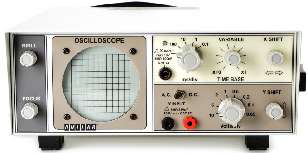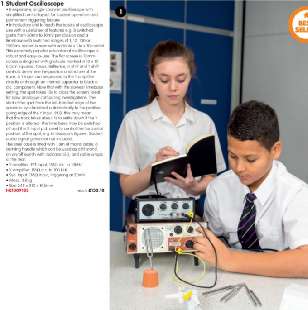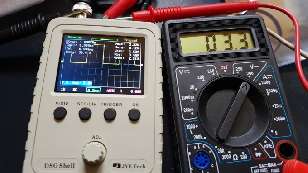Rick's b.log - 2022/02/22
You are 3.144.96.108, pleased to meet you!
Rick's b.log - 2022/02/22 |
|
| It is the 24th of November 2024 You are 3.144.96.108, pleased to meet you! |
|
mailto: blog -at- heyrick -dot- eu
This device was dead simple to use. There's one input channel. The screen is split into ten squares across and ten squares up/down. These are called "divisions".
This device was an eye opener. I was able to see an electric signal, such as sound coming from a Walkman, as it progressed in time. The audio signal started to reveal its secrets.
When I left school, I wanted one, but that sort of thing was out of my disposable budget. That is to say, if I had £150-200 (or however much it was back then) to spend on "whatever", it probably wouldn't be an oscilloscope. I don't do electronics professionally, it's just a hobby and a method of fixing stuff that doesn't work, otherwise my choice of device would likely have a four digit price tag.
It's actually likely to be a good thing I didn't ever buy this. Because... it's okay for school use, but... comically bad otherwise.
I found a publicity brochure "Scotland Excel 2016" by Findel Ltd, which listed plenty of interesting equipment for schools. It's the last mention of the device that I have been able to find. Findel (Philip Harris, Hope Education, Unilab, etc etc) don't appear to sell them anymore.
I like how they've managed to set up an experiment with a signal generator, and found two kids to pretend to be conducting an experiment, but don't appear to have actually turned the device on!
So what's wrong with this, other than being single channel and not having more control over the triggering (it happens on the Y-input going positive)?
Well, the volts/div control isn't that much of a problem. At it's greatest capacity, it can display 10V/div with a theoretical maximum of 100V on the screen, though to be honest you're likely to want to switch to the ÷10 on the probe to avoid shoving that much into the device.
The problem is the timebase. That's the controls at the top. Marked in ms/div, or milliseconds per division, it ranges from 100ms/div to 0.1ms/div.
Now a millisecond is one thousandth of a second. This means that with ten squares across the screen and 100ms/div, the trace will take one second to sweep across the screen. By using the ×10 option, this can be stretched out to be ten seconds to cross the screen.
The fastest screen sweep is 1kHz. This means that each division represents 10kHz. Depending on where you look, this device has a "bandwidth" of 20kHz (Google searches for the Unilab model 032.602) or, as the advert above indicates, 100kHz (the X input).
I would imagine this device is no longer being sold because it can have it's ass handed to it by a €25 kit based around abusing the ADC built into an STM32 microcontroller, like this thing:
The DSO Shell is good up to around 200kHz. I won't comment on the snapshot-and-hold abilities of a digital oscilloscope as it was only freakishly expensive "storage scopes" that could do that using cathode ray technology. But if we were to consider that, it's clear that a friendly £150 device doesn't measure up. But (yup, another 'but') do recall that ARM based microcontrollers didn't exist back in the '80s. The ARM itself only arrived, in an 8MHz incarnation, in 1987.
The first oscilloscope I bought was an ex-school device. Clearly French schools take things more seriously, as there are a fair number of these things around.
With a normal bandwidth of 15MHz (10MHz in some mode (high voltage?)), dual input, and all manner of triggering options, this is an oscilloscope designed to be useful. And it is. Okay, sure, 15MHz isn't a lot these days, but it's more than enough for poking around my old computers should I need to. Not the PC (33MHz) or the RiscPC (40MHz), but certainly all of the eight bit era hardware. And maybe even the A5000 if I don't need to go near the processor (it ran at 25MHz, but the rest of the machine didn't!).
I go into more detail about using an oscilloscope with a closer look at the controls of the Metrix, if you're interested.
Oh, the twos!
I smiled as I wrote today's date on the sheet that I use to write down what consumables are required.
2022/02/22 J2
Musing on oscilloscopes
When I was at school, the Physics lab had a couple of Unilab oscilloscopes.

Unilab oscilloscope, © Hope Education.
The bottom control sets how many volts each division represents, and the upper control sets how fast the trace sweeps across the screen, with the ability to stretch the given duration up to ten times.
The two controls on the left set the brightness and focus of the trace.

Unilab oscilloscope in a catalogue, © Findel Ltd 2016.
This model is a darker brown, like the ones in the Physics lab at school back in the '80s.
At it's smallest capacity, it's 0.05V/div, with a maximum of half a volt on the screen. Pretty good for examining what's going on in your headphones.
The next option, 10ms/div, would take 100ms or one tenth of a second to cross the screen.
The third option, 1ms/div, would take 10ms or on hundredth of a second to cross the screen.
And, clearly, the final option is 0.1ms/div or 1ms to cross the screen. That's a thousandth of a second.
Now 20kHz is really bad. It wouldn't be able to keep up with a cheap watch crystal (32.768kHz). 100kHz? Honestly not that much better really. Okay for simple science experiments, but it would be utterly lost poking around the motherboard of a typical computer of the era (like the 6502 clocking 2MHz).

A DSO Shell oscilloscope kit.
The Mextrix OX710B.
Rob, 23rd February 2022, 23:13 David Pilling, 26th February 2022, 12:52
An analogue scope does have something about it, just like vinyl discs, you're seeing more of reality, there will be situations where digital gives the wrong result.
Uni. had storage scopes too - seemed to be Etch a Sketch tech. from Tektronix, huge pulse of static electricity when it stored an image.
I'd imagine schools do not countenance kit with high voltages inside - how many CRT based monitors are left. Would CRT be approved for home use today.
Your story is about how things have changed - 1GHz (in any context) was once science fiction along with ADCs that could go fast enough to make an o'scope.
Bandwidth still separates the wheat from the chaff but for a lot of playing does not matter much.
David Pilling, 26th February 2022, 13:02
The past is populated by very clever people but with limits.
| © 2022 Rick Murray |
This web page is licenced for your personal, private, non-commercial use only. No automated processing by advertising systems is permitted. RIPA notice: No consent is given for interception of page transmission. |